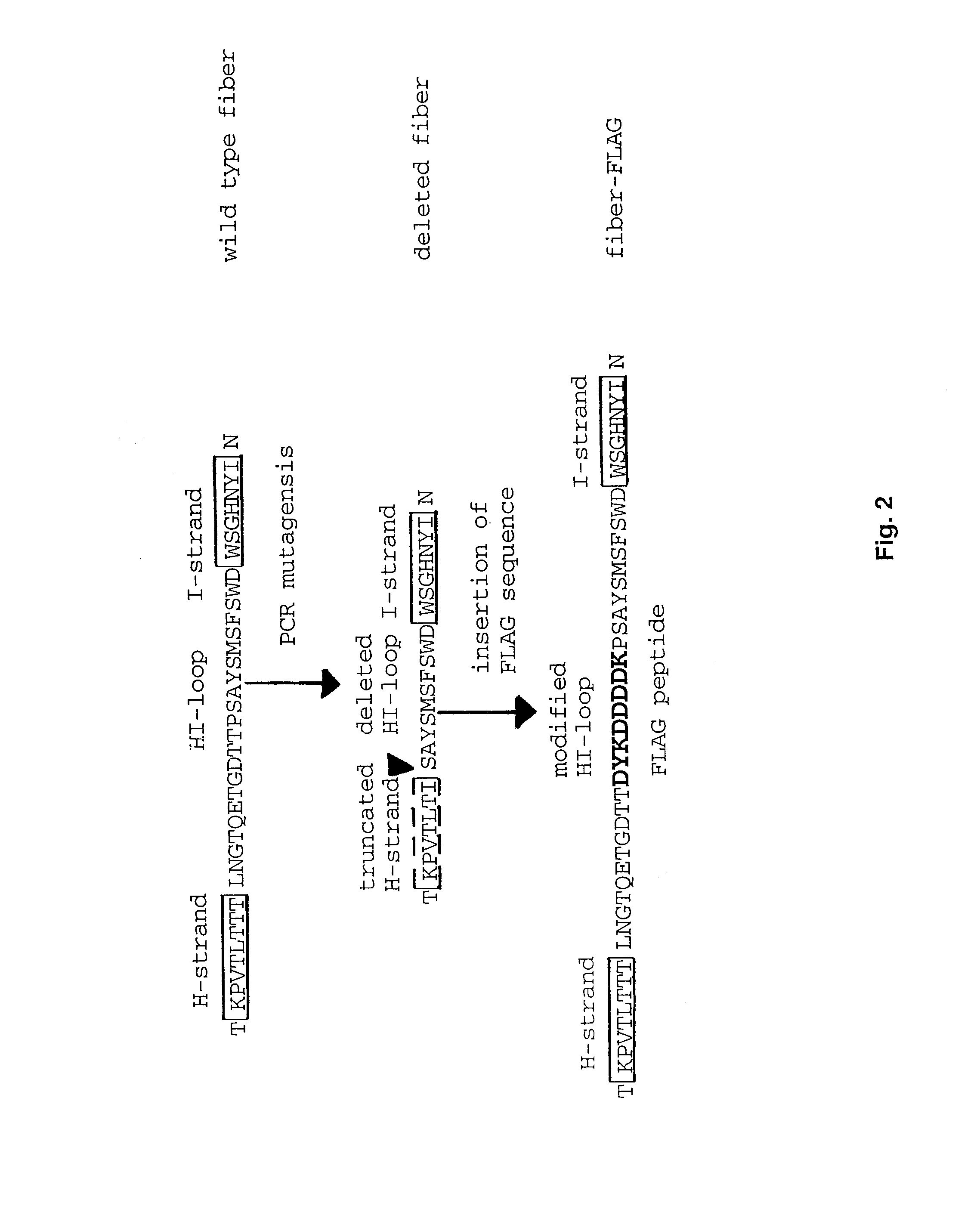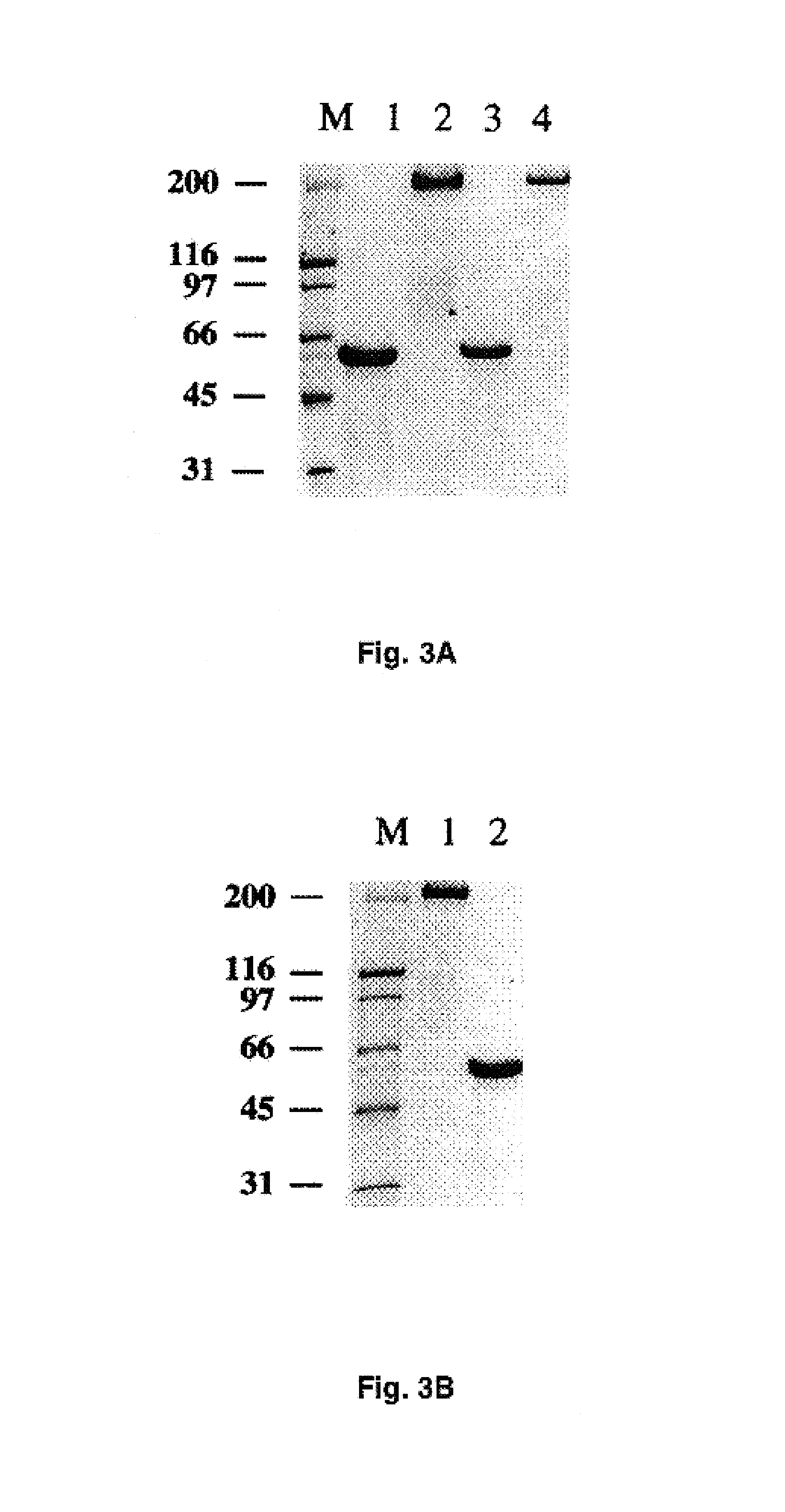Adenovirus vector containing a heterologous peptide epitope in the hi loop of the fiber knob
- Summary
- Abstract
- Description
- Claims
- Application Information
AI Technical Summary
Benefits of technology
Problems solved by technology
Method used
Image
Examples
example 1
Cells
[0080]293 human kidney cell line transformed with Ad5 DNA was purchased from Microbix (Toronto, Ontario, Canada). HeLa human adenocarcinoma cells, A549 human lung carcinoma cells, human umbilical vein endothelial cells (HUVEC) and human embryonal rhabdomyosarcoma cells (RD) were obtained from American Type Culture Collection (Manassis, Va.). Human ovarian carcinoma cell lines SKOV3.ip1 and OV-4 were obtained from Janet Price (M.D. Anderson Cancer Center, Houston, Tex.) and Timothy J. Eberlein (Brigham and Women's Hospital, Boston, Mass.), respectively, and were maintained in Dulbecco's modified Eagle's medium (DMEM)-Ham's F12 from Mediatech (Herndon, Va.) supplemented with 10% fetal calf serum (FCS) (Hyclone Laboratories, Logan, Utah), 100 units / ml penicillin, 100 μg / ml streptomycin at 37° C. and 5% CO2. Primary ovarian carcinoma cells were isolated as follows: Malignant ascites of epithelial ovarian carcinoma were collected during surgery at the Hospital of the University of A...
example 2
Enzymes, Protein Assay and Antibodies
[0081]Restriction endonucleases, T4 DNA ligase, T4 polynucleotide kinase, and proteinase K were from either New England Biolabs (Beverly, Mass.) or Boehringer Mannheim (Indianapolis, Ind.).
[0082]The concentrations of purified proteins were determined by the Bradford protein assay (Bio-Rad, Hercules, Calif.) with bovine gamma globulin as the standard.
[0083]Anti-fiber monoclonal antibodies 4D2 (19) and 1D6.14 (14) were generated at the University of Alabama at Birmingham Hybridoma Core Facility. Anti-FLAG monoclonal antibody M2 and M2-affinity gel were purchased from Scientific Imaging Systems (Eastman Kodak, New Haven, Conn.). Anti-αvβ3 integrin monoclonal antibody LM609 and anti-αvβ3 integrin monoclonal antibody P1F6 were purchased from Chemicon (Chemicon, Temecula, Calif.) and Gibco-BRL (Gibco BRL, Gaithersburg, Md.), respectively. Anti-CAR monoclonal antibody RmcB was obtained from R. W. Finberg (Dana-Farber Cancer Institute, Harvard Medical Sc...
example 3
Flow Cytometry and Indirect Flow Cytofluorometry
[0085]Cells grown in T75 flasks were versene released and resuspended in SM buffer (Hepes buffered saline, 0.1% sodium azide, 1% BSA) at 2×106 cell / ml. Two hundred thousand cells were incubated with 5 μgml LM609, P1F6, RmcB, or no primary mAb (negative control) in 200 μl SM for 2 hours at 4° C. Cells were then washed with SM and incubated with 5 μg / ml secondary FITC-labeled goat anti-mouse IgG serum (Jackson Labs, West Grove, Pa.) for 1 hour at 4° C. After SM wash, 104 cells per sample were analyzed by flow cytometry at the UAB FACS Core Facility.
[0086]Cultured cells were washed with PBS and harvested with Versene (GibcoBRL) for 15 min. Detached cells were centrifuged and resuspended in PBS containing 1% bovine serum albumin (BSA) and 0.1% sodium azide (1% BSA / PBS) at a concentration of 105 cells / ml. The cells were then incubated with primary antibodies for 1 h on ice. Subsequently, the cells were washed and incubated with FITC-conjuga...
PUM
| Property | Measurement | Unit |
|---|---|---|
| Therapeutic | aaaaa | aaaaa |
Abstract
Description
Claims
Application Information
 Login to View More
Login to View More - R&D
- Intellectual Property
- Life Sciences
- Materials
- Tech Scout
- Unparalleled Data Quality
- Higher Quality Content
- 60% Fewer Hallucinations
Browse by: Latest US Patents, China's latest patents, Technical Efficacy Thesaurus, Application Domain, Technology Topic, Popular Technical Reports.
© 2025 PatSnap. All rights reserved.Legal|Privacy policy|Modern Slavery Act Transparency Statement|Sitemap|About US| Contact US: help@patsnap.com



